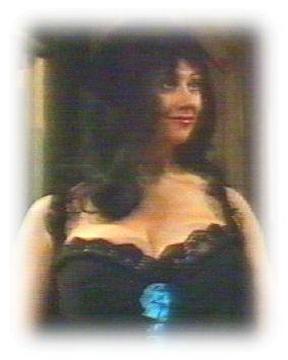Classic TV anarchy from Milligan who, with writing partner Neil Shand, liked to present material that crossed lines of
decency and taste in a quest to take comedy into unexplored territory.
With their surreal sketch ideas, costumes that still bore the BBC prop department tags, half constructed sets, often
bizarre make-up and air of uncontrolled chaos, the Q shows were certainly groundbreaking and pipped Python to
the post with their deliberate avoidance of punchlines, many of the sketches segueing into the next routine or simply being
abandoned half way through.
Television scarcely seemed able to contain the sprawling scope of the Q shows, and the shows baffled and angered
as many viewers as they entertained. Milligan's relationship with his BBC masters was fraught during much of the run: he always
wanted to direct the shows himself, propelling them into ever weirder areas, but the executives thought that he needed a strong
hand on the tiller.
Reputedly (but oddly), they refused to allow the final series to be titled Q10, thinking that the baffling Q
prefix had been around for long enough, so Milligan - possibly with a nod towards such 'official' thinking - renamed it There's
A Lot Of It About.
Although their importance within the development of the genre is recognised, the Q shows do not enjoy the same posthumous
reverence among fans and critics that is reserved for Monty Python's Flying Circus.
There are, arguably, three main reasons for this. Firstly, the Q shows were comedically less consistent, with moments
of genius squeezed in between bouts of charmless corn. (This was probably because Milligan himself, with Shand, did the bulk
of the writing, and his own idiosyncratic flights of fancy could be hit and miss, whereas the Pythons all wrote, the
members exercising a kind of quality control mechanism over the others' writing, ensuring that flimsy material was rejected.)
Secondly, there is the question of taste - Milligan's rather old-fashioned shock value usage of racial abuse (jokes about
'wogs' and 'Pakis') and sexual situations (the semi-clad, mammoth-breasted Julia Breck as sexual predator) were acceptable
in the climate of the 1970s but don't age as well as the Pythons' shock material (homosexual brigadiers, cannibal undertakers)
where authority figures bear the brunt of the humour.
Lastly, there is the construction of the programmes - whereas both Q and Python had almost limitless freedom
to leave a sketch at any point and play with the reality of the show and the genre of television, Terry Gilliam's brilliant
animations permitted Python to effect seamless transitions from one sketch to the next, which, when coupled with the
Pythons' faultless sense of programme continuity, gave their shows a greater all-round balance.
Notwithstanding all of this, the Q shows provided Spike Milligan with his longest TV run and
brought his humour firmly into the 1970s, delighting old and new fans alike.
--------------------------------------------------------------
As recalled by Bob Wingrove from bustation.net( A website dedicated to resources for bus-related links on the Web. The BUS
STATION is now one of the biggest on the internet.)(Who said train spotters were the leading anoraks?) - a sketch in Spike
Milligan's Q series featuring Milligan as a bus conductor with a false nose aboard an AEC RT.
"I think at this time the BBC had a stock bus as a prop (this was probably the same RT) with most of the nearside lower saloon
side panels removed so you could film people inside. (I think it was shown as such during the same programme."
Also an RT (probably the same one) crashing through the wall in Milligan's version of the 'Chinese Restaurant' joke ('I'll
have a number 19....!')
Scot Fergie adds to Bob's comments: "Spike Milligan was playing Richard III in a sketch about the British public being unable
to get theatre tickets and the 'London Passenger Transport Board"' (Milligan's fairly accurate quote) obliges by performing
on the buses. He's dressed as a conductor with Richard III hair/hump and a coronet on top of his hat:
Passenger - (Alan Clare) 'Two to the bit where Queen Anne gobs in your face..' Milligan - 'Spittalfields !' Mid way through
an RM appears on film travelling down what looks like Oxford Street on a faked up blind on a 247A "RICHARD THE THIRD" - can't
make the reg out from my poor video copy - but looks like a "WLT8xx" four bay machine.
The sketch continues in the studio with the cut-away vehicle running up the back of a '6A Midsummers Night's Dream'.
It then cuts to a shot of the upper deck stairwell of an open-topped rear-entrance vehicle whilst Milligan appears up the
stairs dressed as Rudolph Valentino with an LT conductors hat and a banjo asking 'Where else would you get The Desert Song
for fourpence on a 137?'
This shot the vehicle has wood slatted seats and the interior panels and seating are all painted uniform dark blue (an ex
BMMO D9 open top vehicle on the sightseeing tour?)
The cut away vehicle - (astonishingly accurately remembered by Bob) appears in the background (showing the whole lower deck
of the vehicle, but unfortunately not a wide enough shot to show whether it still retained a top deck) of the previous musical
number with Alan Clare playing 'The Way We Were' on piano.
What was this bus?
The programme was Q7, episode 5, transmitted on 31 January 1978.

|
| Julia Breck and her enormous breasts! |



